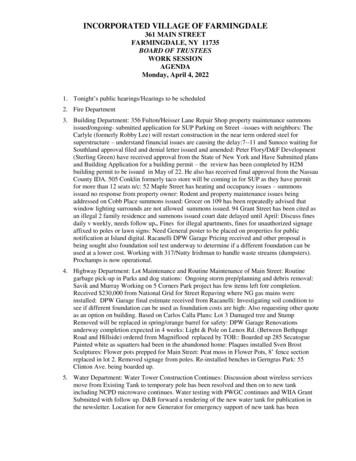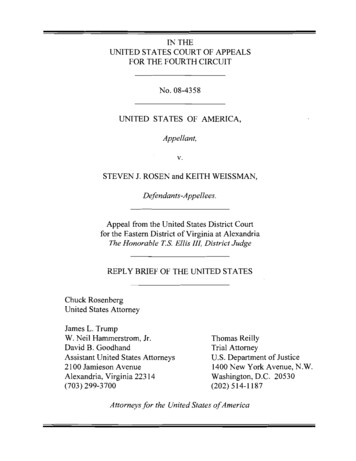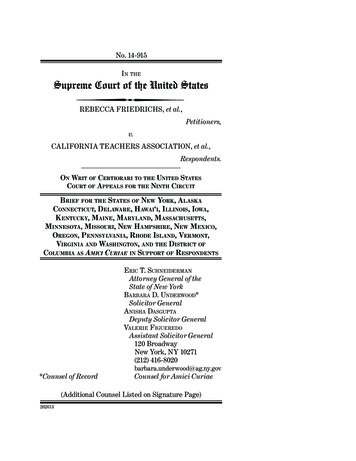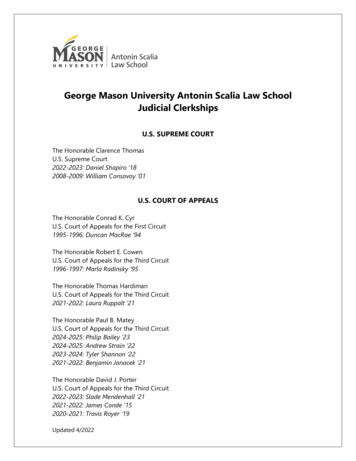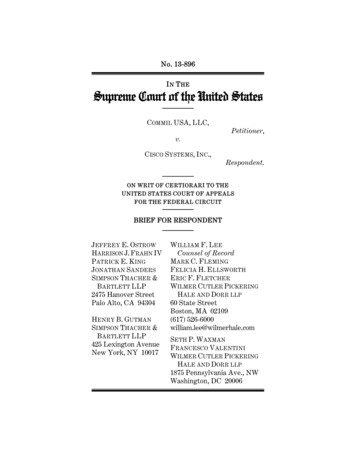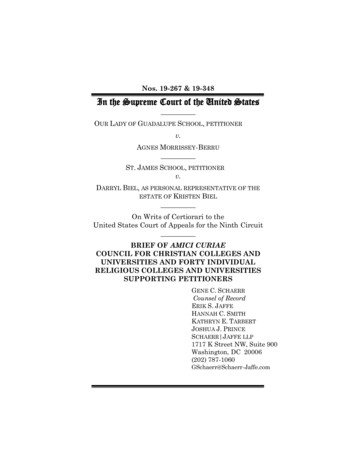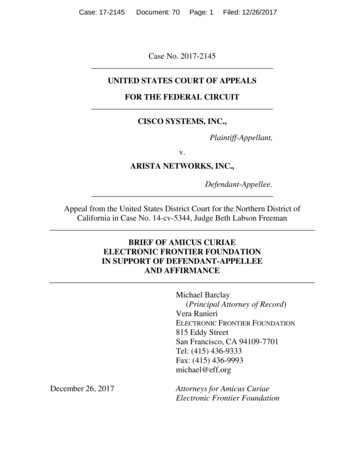
Transcription
Case: 17-2145Document: 70Page: 1Filed: 12/26/2017Case No. 2017-2145UNITED STATES COURT OF APPEALSFOR THE FEDERAL CIRCUITCISCO SYSTEMS, INC.,Plaintiff-Appellant,v.ARISTA NETWORKS, INC.,Defendant-Appellee.Appeal from the United States District Court for the Northern District ofCalifornia in Case No. 14-cv-5344, Judge Beth Labson FreemanBRIEF OF AMICUS CURIAEELECTRONIC FRONTIER FOUNDATIONIN SUPPORT OF DEFENDANT-APPELLEEAND AFFIRMANCEMichael Barclay(Principal Attorney of Record)Vera RanieriELECTRONIC FRONTIER FOUNDATION815 Eddy StreetSan Francisco, CA 94109-7701Tel: (415) 436-9333Fax: (415) 436-9993michael@eff.orgDecember 26, 2017Attorneys for Amicus CuriaeElectronic Frontier Foundation
Case: 17-2145Document: 70Page: 2Filed: 12/26/2017CERTIFICATE OF INTERESTPursuant to Federal Circuit Rules 29(a) and 47.4, counsel for AmicusCuriae certifies that:1.The full name of the amicus I represent is:Electronic Frontier Foundation2.The name of the real party in interest (if the party named in thecaption is not the real party in interest) I represent is:N/A3.All parent corporations and any publicly held companies that own10 percent or more of the stock of the amici curiae I represent are:None.4.The names of all law firms and the partners or associates thatappeared for the amicus I represent or are expected to appear in this Court are:Michael Barclay and Vera Ranieri, Electronic Frontier Foundation, SanFrancisco, California.5.The title and number of any case known to counsel to be pending inthis or any other court or agency that will directly affect or be directly affectedby this court’s decision in the pending appeal are: None.December 26, 2017/s/ Michael BarclayMichael BarclayAttorneys for Amicus CuriaeElectronic Frontier Foundationi
Case: 17-2145Document: 70Page: 3Filed: 12/26/2017TABLE OF CONTENTSPageCERTIFICATE OF INTEREST. iTABLE OF AUTHORITIES . ivTABLE OF CONVENTIONS . viiiSTATEMENT OF IDENTITY AND INTEREST OF AMICUS CURIAE . 1INTRODUCTION AND SUMMARY OF ARGUMENT. 1ARGUMENT. 2I. The Ninth Circuit Has Rejected Oracle’s Approach to Copyrightability . 2A. Bikram’s Yoga Resolved an Issue this Court Believed the NinthCircuit Had Not Decided . 31.Oracle Assumed that the Ninth Circuit Had Not Addressed“the Precise Issue” in that Case . 32.Bikram’s Yoga Shows that this Court’s “Multiple Ways toExpress” Reasoning Is Not Good Law in the Ninth Circuit . 4B. The Court Should Take this Opportunity to Correct ItsInterpretation of the Ninth Circuit’s Approach toCopyrightability . 5II.Cisco’s Multiword Commands and Compilations Are UncopyrightableUnder § 102(b) . 8A. Courts in Several Circuits Have Rejected Similar CopyrightClaims. 8B. Cisco Cannot Claim Infringement of a Compilation That Did NotExist Prior to Litigation. 12III. If the Court Confirms Copyrightability, It Should Affirm the Jury’sFinding that Arista’s Activities Were Lawful . 14A. The Guiding Question for the Scènes à Faire Analysis Is WhetherExtrinsic Factors Dictated the Creators’ Choices, Not WhetherAlternative Choices Existed . 15B. A Jury Could Reasonably Find that Extrinsic Factors DictatedArista’s Choices . 16ii
Case: 17-2145Document: 70Page: 4Filed: 12/26/2017IV. Upholding the Jury Finding Protects Competition and Innovation . 20A. Where Works at Issue Are Highly Functional, Courts Should BeParticularly Deferential to a Jury Finding of Scènes à Faire . 20B. If Cisco’s Approach Had Been the Industry Standard, CopyrightClaims Could Have Stifled the Emergence of Key Technologies . 221.The BIOS of the Original IBM-Compatible PC . 222.Major Modern Operating Systems’ Reimplementation ofthe Groundbreaking UNIX Interface . 253.The C Programming Language . 274.Industry Standards for Cloud Computing . 295.Creation of Software That Otherwise Would Not BeWritten. 31CONCLUSION . 33CERTIFICATE OF SERVICE . 34CERTIFICATE OF COMPLIANCE WITH TYPE-VOLUME LIMITATION,TYPEFACE REQUIREMENTS, AND TYPE STYLE REQUIREMENTSPURSUANT TO FED. R. APP. P. 32(a)(7)(C). 35iii
Case: 17-2145Document: 70Page: 5Filed: 12/26/2017TABLE OF AUTHORITIESPage(s)CasesApple Computer, Inc. v. Microsoft Corp.,35 F.3d 1435 (9th Cir. 1994) . 14, 15Bikram’s Yoga College of India, L.P. v. Evolation Yoga, LLC,803 F.3d 1032 (9th Cir. 2015) . 3, 4, 5, 15Cisco Sys. Inc. v. Arista Networks, Inc.,No. 14-cv-05344, 2016 WL 4440239, Order re Summ. J.(N.D. Cal. Aug. 23, 2016) .14Feist Publ’ns, Inc. v. Rural Tel. Serv. Co., Inc.,499 U.S. 340 (1991) . 12, 13, 15Gates Rubber Co. v. Bando Chem. Indus., Ltd.,9 F.3d 823 (10th Cir. 1993) .11Gates Rubber Co. v. Bando Chem. Indus., Ltd.,No. 92–S–136 (D. Colo. filed June 12, 1995) .11Harper House, Inc. v. Thomas Nelson, Inc.,889 F.2d 197 (9th Cir. 1989) .13Landsberg v. Scrabble Crossword Game Players, Inc.,736 F.2d 485 (9th Cir. 1984 .16Lexmark Int’l, Inc. v. Static Control Components, Inc.,387 F.3d 522 (6th Cir. 2004) . 21, 22Lotus Dev. Corp. v. Borland Int’l, Inc.,49 F.3d 807 (1st Cir. 1995) . passimLotus Dev. Corp. v. Borland Int’l, Inc.,831 F. Supp. 202 (D. Mass. 1993) . 8, 9, 10Lotus Dev. Corp. v. Paperback Software Int’l,740 F. Supp. 37 (D. Mass. 1990) .8, 9iv
Case: 17-2145Document: 70Page: 6Filed: 12/26/2017MiTek Holdings, Inc. v. Arce Engineering Co., Inc.,89 F.3d 1548 (11th Cir. 1996) . 11, 14Oracle Am., Inc. v. Google Inc.,750 F.3d 1339 (Fed. Cir. 2014). passimPaterson v. Little, Brown & Co.,502 F. Supp. 2d 1124 (W.D. Wash. 2007).26Sega Enters. Ltd. v. Accolade, Inc.,977 F.2d 1510 (9th Cir. 1992) .22Sony Computer Ent’mt, Inc. v. Connectix Corp.,203 F.3d 596 (9th Cir. 2000) .20Statutes17 U.S.C. § 101 .1217 U.S.C. § 102 . passimOther AuthoritiesAbout Wine, WineHQ, http://www.winehq.org/about/.32Amazon Web Services (AWS) and Eucalyptus Partner to Bring AdditionalCompatibility Between AWS and On-Premises IT Environments,Eucalyptus (Mar. 22, 2012), and-eucalyptus-partner. .30Brian W. Kernighan & Dennis M. Ritchie, The C Programming Language(1978) .28Business Applications, Amazon Web ns .30Charles H. Ferguson & Charles R. Morris, Computer Wars: The Fall of IBMand the Future of Global Technology (1994) . 23, 24Compaq Computer Corporation: Portable Computer, EncyclopædiaBritannica, rporation .24v
Case: 17-2145Document: 70Page: 7Filed: 12/26/2017CRT Library Features, Microsoft Developer time-library/crt-libraryfeatures .28Heather J. Meeker, The Open Source Alternative (2008). 25, 26Ingrid Marson, Microsoft Admits Targeting Wine Users, ZDnet(Feb. 25, e-users-3039189180/ .32Jeff Tyson, How BIOS Works, os1.htm .23Jonathan Band, Software Copyright Litigation After Oracle v. Google,Disco (January 9, 2017), le/ .7Margaret Rouse, Definition: Virtual Machine (VM), SearchServerVirtualization(Oct. 2011), efinition/virtual-machine . 29, 30Matthew Schwartz, Reverse-Engineering, Computerworld (November 12,2001), velopment/reverse-engineering.html.24Microsoft Press Computer Dictionary (2d Ed. 1994) .23Milestones in AT&T History, .html .25Netmarketshare, Mobile Operating System Market Share (Nov. stem-marketshare.aspx?qprid 8&qpcustomd 1&qptimeframe M .27Operating System Development Over Time, TOP500 Supercomputer List,http://www.top500.org/statistics/overtime/ .27Pamela Samuelson, Three Fundamental Flaws in CAFC’s Oracle v. GoogleDecision, 37 Eur. Intell. Prop. Rev. 702 tract id 2643840 .6vi
Case: 17-2145Document: 70Page: 8Filed: 12/26/2017Peter Menell, API Copyrightability Bleak House: Unraveling and Repairingthe Oracle v. Google Jurisdictional Mess, 31 Berkeley Tech. L.J. 1515(2016) .7Scott Swigart & Sean Campbell, Interview with Alexandre Julliard, Head of theWine Project/CTO of CodeWeavers, How Software is Built (Sept. 8, -of-CodeWeavers/ .32Steven J. Vaughan-Nichols, How Many Linux Users Are There (Really)?Linux Planet (Feb. 18, ts/6671/1. 26, 27Steven J. Vaughan-Nichols, OpenStack vs. CloudStack: The Beginning of theOpen-Source Cloud Wars, ZDNet (Apr. 12, tack-the-beginning-of-the-open-source-cloudwars/ .30The GNU C Library (glibc), The GNU Project,http://www.gnu.org/software/libc/ .28The Native Android API, Mobile -api/. .28Usage of operating systems for websites, perating system/all .27Usage statistics and market share of Unix for websites, s-linux/all/all .27Van Lindberg, Intellectual Property and Open Source: A Practical Guideto Protecting Code (2008) . 23, 24What is Cloud Computing?, Amazon Web Services,http://aws.amazon.com/what-is-aws .29vii
Case: 17-2145Document: 70Page: 9Filed: 12/26/2017TABLE OF CONVENTIONSCiscoPlaintiff-Appellant Cisco Systems, Inc.AristaDefendant- Appellee Arista Networks,Inc.Cisco Br.Cisco’s Opening Brief, dated September13, 2017Arista Br.Arista’s Response Brief, dated December22, 2017Mathworks Br.Amicus Brief of The Mathworks, Inc. etal., dated September 20, 2017AppxThe appellate Appendix in this appealviii
Case: 17-2145Document: 70Page: 10Filed: 12/26/2017STATEMENT OF IDENTITY AND INTEREST OF AMICUS CURIAE1The Electronic Frontier Foundation (“EFF”) is a non-profit civil libertiesorganization that has worked for 26 years to protect consumer interests,innovation, and free expression in the digital world. EFF and its more than40,000 dues-paying members have a strong interest in helping the courts andpolicymakers strike the appropriate balance between intellectual property andthe public interest, and ensuring that copyright law serves the interests ofcreators, innovators, and the general public.Pursuant to Fed. R. App. P. 29(a), all parties have consented to the filingof this brief.INTRODUCTION AND SUMMARY OF ARGUMENTThe Court should affirm the judgment below.First, the works in question (to the extent they can be adequatelydiscerned) are not copyrightable under Ninth Circuit law. Cisco and its amicirely on this Court’s holding, in Oracle,2 that the Ninth Circuit would treat awork as copyrightable if there were multiple ways to express the underlying1No party’s counsel authored this brief in whole or in part. Neither any partynor any party’s counsel contributed money that was intended to fund preparingor submitting this brief. No person other than amicus, its members, or itscounsel contributed money that was intended to fund preparing or submittingthis brief. Web sites cited in this brief were last visited on December 18 & 19,2017.2Oracle Am., Inc. v. Google Inc., 750 F.3d 1339, 1367 (Fed. Cir. 2014)(“Oracle”).1
Case: 17-2145Document: 70Page: 11Filed: 12/26/2017idea. But a subsequent Ninth Circuit opinion rejected that approach. Now thatthe Ninth Circuit has clarified its law, this Court should revisit its holding inOracle, and find the works at issue uncopyrightable.And the flaws in Cisco’s copyrightability analysis do not end there. Theoverwhelming body of precedent weighs against granting copyright protectionfor computer menu commands similar to those at issue, under 17 U.S.C.§ 102(b) (“§ 102(b)”). What’s more, Cisco appears to be claiming that Aristainfringed a copyright in a so-called compilation that was selected and arrangedyears later, solely for purposes of this litigation.Second, even if the Court affirms the copyrightability of the“compilations” at issue, the facts, the law, and strong public policy support thejury’s scènes à faire verdict. Indeed, if courts are going to grant copyrightprotection to functional works, robust defenses such as scènes à faire helpensure that protection does not impede competition and innovation. The jurydid its job, and this Court should leave its conclusion undisturbed.ARGUMENTI.THE NINTH CIRCUIT HAS REJECTED ORACLE’S APPROACHCOPYRIGHTABILITYTOCisco and its amici rely on Oracle for the proposition that the works atissue are copyrightable because there were multiple ways to express the sameidea. Oracle, 750 F.3d at 1367. See Cisco Br. at 38, 40; Mathworks Br. at 9.2
Case: 17-2145Document: 70Page: 12Filed: 12/26/2017Oracle is no longer good law for that proposition.A.Bikram’s Yoga Resolved an Issue this Court Believed the NinthCircuit Had Not DecidedBetween the time of the 2014 Oracle opinion and this appeal, the NinthCircuit issued its opinion in Bikram’s Yoga College of India, L.P. v. EvolationYoga, LLC, 803 F.3d 1032 (9th Cir. 2015). That opinion clarified the NinthCircuit’s view of copyrightability, a question this Court believed wasunresolved. In light of this new authority, the works at issue in this case and inOracle are not copyrightable under Ninth Circuit law.1.Oracle Assumed that the Ninth Circuit Had NotAddressed “the Precise Issue” in that CaseIn order to decide the copyrightability issue, the Oracle court had todetermine whether the structure, sequence, and organization of the Java APIpackages was copyrightable under § 102(b). Oracle, 750 F.3d at 1364-65. TheCourt declined to follow Lotus Dev. Corp. v. Borland Int’l, Inc., 49 F.3d 807(1st Cir. 1995) (“Lotus”), aff’d by an equally divided court, 516 U.S. 233(1996). The Court believed that Lotus was distinguishable and that the NinthCircuit would not follow the Lotus court’s reasoning. 750 F.3d at 1365-66.Given a belief that the Ninth Circuit had not “addressed the precise issue” in thatcase, this Court came to its own conclusion about what the Ninth Circuit woulddo:3
Case: 17-2145Document: 70Page: 13Filed: 12/26/2017We agree with Oracle that, under Ninth Circuit law, an originalwork—even one that serves a function—is entitled to copyrightprotection as long as the author had multiple ways to express theunderlying idea.Id. at 1367.Even assuming this was an accurate statement of Ninth Circuit law in2014, it is not an accurate statement now.2.Bikram’s Yoga Shows that this Court’s “Multiple Waysto Express” Reasoning Is Not Good Law in the NinthCircuitIn October 2015, the Ninth Circuit considered a copyright claim in asequence of yoga poses. Bikram’s Yoga, 803 F.3d 1032. Bikram Choudhuryand his company, Bikram’s Yoga, had sued a competitor who used the samesequence. Simply put, Choudhury was claiming copyright in a process forimproving one’s health by practicing certain yoga poses in a specific order.Relying on § 102(b), the court concluded that a “Sequence” of 26 yogaposes and two breathing exercises, performed in a particular order, was notsubject to copyright protection. Writing for the court, Judge Wardlaw stressedthat copyright recognizes a “vital distinction” between ideas and expression, so“the copyright for a work describing how to perform a process does not extendto the process itself.”Id. at 1037-38.Choudhury himself described hisSequence as a “system” or “method” to use yoga to optimize the body’s healthand function. Id. at 1038-39. Given that, Judge Wardlaw had little difficulty4
Case: 17-2145Document: 70Page: 14Filed: 12/26/2017concluding that the idea/expression dichotomy, codified in § 102(b), precludedcopyright protection of the Sequence. Id. at 1039-40.Bikram’s Yoga also considered, and rejected, the argument that a systemor method can be copyrightable if there were different ways to “express” thatsystem. The Ninth Circuit held:It makes no difference that similar results could be achievedthrough a different organization of yoga poses and breathingexercises. . . . the possibility of attaining a particular end throughmultiple different methods does not render the uncopyrightable aproper subject of copyright. Though it may be one of manypossible yoga sequences capable of attaining similar results, theSequence is nevertheless a process and is therefore ineligible forcopyright protection.803 F.3d at 1042 (citations, quotations, and footnote omitted).A finding of copyrightability based on the fact that “the author hadmultiple ways to express the underlying idea,” Oracle, 750 F.3d at 1367, cannotbe reconciled with the Ninth Circuit’s holding above. This Court’s “multipleexpressions” theory is not the law in the Ninth Circuit, and therefore should notapply in this case.B.The Court Should Take this Opportunity to Correct ItsInterpretation of the Ninth Circuit’s Approach toCopyrightabilityIt is important that the Court recognize the change of law outlined above.First, Oracle has been criticized as “deeply flawed and at odds with morethan two decades of copyright precedents applying copyright law to computer5
Case: 17-2145Document: 70Page: 15Filed: 12/26/2017programs.” Pamela Samuelson, Three Fundamental Flaws in CAFC’s Oracle v.Google Decision, 37 Eur. Intell. Prop. Rev. 702, 708 (2015).3 In particular, itcreated an unnecessary split with the First Circuit holding in Lotus, 49 F.3d 807.Using language quite similar to Bikram’s Yoga, Lotus also rejected Cisco’s“multiple ways to express” argument:The fact that Lotus developers could have designed the Lotus menucommand hierarchy differently is immaterial to the question ofwhether it is a “method of operation.” . . . The “expressive” choicesof what to name the command terms and how to arrange them donot magically change the uncopyrightable menu commandhierarchy into copyrightable subject matter.49 F.3d at 816. The Oracle decision was based in part on the mistaken premisethat the Ninth Circuit would not follow Lotus, see Oracle, 750 F.3d at 1365-66.Bikram’s Yoga dispels that perception and creates an opportunity to reconcilethe circuits.Second, correcting Oracle avoids the serious practical problems that ariseif courts treat methods of operating a computer as copyrightable. Indeed, asoutlined in detail in amicus briefs filed by numerous prominent computerscientists in both Oracle appeals, the pervasive belief and expectation that APIswere uncopyrightable was essential to the development of modern computersand the Internet. See Corrected Brief of Amici Curiae Computer Scientists, filedMay 30, 2013 in the first appeal in Oracle (Fed. Cir. Case No. 2013-1021,3Available at https://papers.ssrn.com/sol3/papers.cfm?abstract id 2643840.6
Case: 17-2145Document: 70Page: 16Filed: 12/26/2017Docket No. 118);4 Brief of Computer Scientists as Amici Curiae, filed May 30,2017 in the second appeal in Oracle (Fed. Cir. Case No. 2017-1118, Docket No.175).5Reversing that expectation has already sparked “a new wave of litigationconcerning copyright and interoperability”—including this very case. JonathanBand, Software Copyright Litigation After Oracle v. Google, Disco (January 9,2017).6 Oracle has fostered a form of “appellate forum shopping,” where aplaintiff bringing an API-related case that properly sounds in copyrightnonetheless tacks on a patent claim—perhaps even knowing that the claimwouldn’t survive trial—to ensure that any appeal will go to this Court. Suchplaintiffs want to avoid regional circuits, such as the Ninth and First Circuits,that would make short shrift of API copyright claims. See Peter Menell, APICopyrightability Bleak House: Unraveling and Repairing the Oracle v. GoogleJurisdictional Mess, 31 Berkeley Tech. L.J. 1515, 1581 (2016) (Oracle“motivates software intellectual property owners to bundle patent and copyrightclaims in order to take advantage of the Federal Circuit’s expansiveinterpretation of software copyright protection.”).7 Notably here, the jury ruled4Available at -scientists.Available at micus-brief.6Available at le/.7Available at https://papers.ssrn.com/sol3/papers.cfm?abstract id 2859740.57
Case: 17-2145Document: 70Page: 17Filed: 12/26/2017against Cisco on its patent claim, Appx1430-1431, but Cisco’s copyright appealhas gone to this Court. Cisco’s brief barely mentions (if at all) the adverse juryverdict on patent infringement, which Cisco did not appeal.II.CISCO’S MULTIWORD COMMANDSUNCOPYRIGHTABLE UNDER § 102(B)ANDCOMPILATIONSAREAs an alternate ground for affirmance, the Court should hold that thecompilation of the unprotected multiword commands at issue here areuncopyrightable under § 102(b).A.Courts in Several Circuits Have Rejected Similar CopyrightClaimsCourts around the nation have held that names of commands used tocontrol a computer program are not properly the subject of copyright, despite thefact that there are “multiple ways to express” the commands. Cisco’s CLIcommands and their arrangements are not meaningfully different from thoserejected methods of operation.In particular, Cisco’s CLI commands are directly comparable to thespreadsheet commands and hierarchy at issue in Lotus.The First Circuitopinion describes them briefly, and several predecessor district court opinionsoffer more detail. See Lotus Dev. Corp. v. Borland Int’l, Inc., 831 F. Supp. 202(D. Mass. 1993) (“Borland III”), and Lotus Dev. Corp. v. Paperback SoftwareInt’l, 740 F. Supp. 37 (D. Mass. 1990) (“Paperback”). There are 469 commands8
Case: 17-2145Document: 70Page: 18Filed: 12/26/2017arranged in a hierarchy of more than 50 menus and submenus, called a menu“tree.” Lotus, 49 F.3d at 809-10. The menus contain a serious of words that arecommand choices such as “Copy,” “Print,” “Quit,” and “File.” Id. at 809;Borland III, 831 F. Supp. at 210; Paperback, 740 F. Supp. at 64. The top line ofthe main menu presents choices of the commands “Worksheet Range CopyMove File Graph Data Quit.” Choosing certain of those commands brings up alist of subchoices. For example, to select the “Currency” operation, the userwould navigate the menu tree through “Range,” “Format,” and then “Currency.”Borland III, 831 F. Supp. at 210. Using these hierarchical commands, the useroperates the electronic spreadsheet.Cisco’s arrangement does the same thing here; the only difference is thatits commands operate network switches instead of a spreadsheet. Cisco Br. at 6.Like Lotus, Cisco “organized and arranged the multiword commands (andrelated responses) into different, particular hierarchies.” Id. at 9. The examplesof Cisco menu trees shown on pages 9-10 of the Cisco Br. operate the same wayas the Lotus 1-2-3 menu tree, except that Cisco uses commands suitable for anetwork switch such as “ip” or “show.” Id.The following comparison shows how the two menu trees are arranged ina similar manner.9
Case: 17-2145Document: 70Page: 19Portion of Lotus 1-2-3 Menu TreeBorland III, 831 F. Supp. at 210Filed: 12/26/2017Cisco Menu Tree, “ip” hierarchyCisco Br. at 9Lotus argued that the words it chose for its commands, and theirhierarchy, were copyrightable because there were supposedly expressive choicesto use for those words. For example, “Quit” could be renamed “Exit,” and“Copy” could be renamed “Clone,” “Duplicate,” or others. Lotus, 49 F.3d at810-11. Similarly, Cisco argues here that it had numerous choices to select itsnetwork command names and organization, such as renaming “ip” either “ipv4”or “internet-protocol” or others. Cisco Br. at 11-14.The Lotus district court held that these so-called expressive choices meantthat the menu command hierarchy was copyrightable. Lotus, 49 F.3d at 811.The First Circuit reversed, relying on § 102(b). It held that the selection ofnames of menu items in the Lotus 1-2-3 computer program “is not copyrightablebecause it is part of Lotus 1-2-3’s ‘method of operation.’” Id. at 816. The Lotus1-2-3 menu commands were like buttons on a VCR; in both cases the user10
Case: 17-2145Document: 70Page: 20Filed: 12/26/2017operates the spreadsheet program or the videotaping machine by pushingbuttons. Id. at 817. Or, as Arista’s expert explained to the jury, the Cisco CLIcommands were like “knobs” on an old-style stereo. Arista Br. at 8, 42.Given the similarity of function between the Lotus 1-2-3 menu commandsand the Cisco CLI commands, the same result should occur here. That isparticularly the case given that the Ninth Circuit has now agreed with the FirstCircuit that “expressive” choices of what to name commands does not“magically” render otherwise uncopyrightable subject matter copyrightable.Lotus, 49 F.3d at 816.Other circuits considering the copyrightability of menu commands havereached the same result. Gates Rubber Co. v. Bando Chem. Industries, Ltd., 9F.3d 823 (10th Cir. 1993), involved a computer program used to select industrialmachine belts. The Tenth Circuit vacated a district court decision holding thatthe program’s menu commands were copyrightable, and gave the district courtinstructions for further consideration of the issue. Id. at 843-44. On remand, thedistrict court held that the menu commands were uncopyrightable, citing Lotusapprovingly. Gates Rubber Co. v. Bando Chem. Indus., Ltd., No. 92–S–136,slip opn. at 6-7 (D. Colo. filed June 12, 1995) (not appealed).8 Similarly, MiTekHoldings, Inc. v. Arce Engineering Co., Inc., 89 F.3d 1548 (11th Cir. 1996) dealt8Available at https://www.eff.org/document/gates-rubber-v-bando
viii TABLE OF CONVENTIONS Cisco Plaintiff-Appellant Cisco Systems, Inc. Arista Defendant- Appellee Arista Networks, Inc. Cisco Br. Cisco's Opening Brief, dated September

